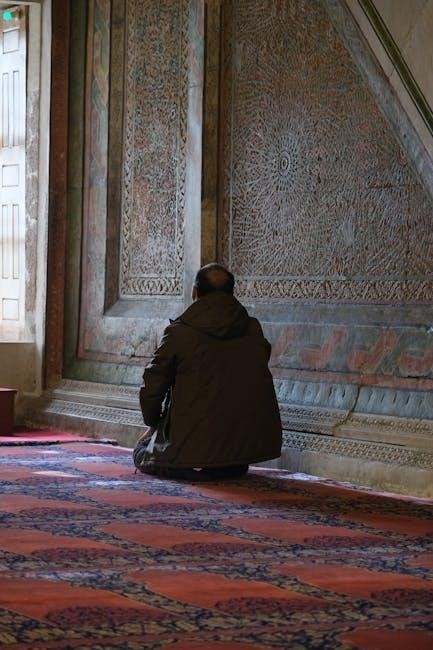The Amidah Prayer, also known as the Standing Prayer, is a central component of Jewish worship. Recited three times daily, it consists of 18 blessings, later expanded to 19. A PDF version provides a convenient way to access and study this prayer, offering insights into its structure and significance in Jewish tradition.
1.1. Significance of the Amidah in Jewish Prayer
The Amidah, or Standing Prayer, is the cornerstone of Jewish worship, recited three times daily. It serves as a direct dialogue with God, allowing individuals to express their deepest thoughts and emotions. The prayer’s structure, comprising 18 blessings (later expanded to 19), reflects the Jewish people’s spiritual aspirations, gratitude, and requests. Its significance lies in its universality, making it accessible to all, regardless of personal circumstances.
The Amidah’s enduring importance stems from its ability to connect the individual with the divine, fostering a sense of community and unity. Its words, rich in history and meaning, provide a spiritual anchor, guiding Jews in their daily lives. A PDF version of the Amidah offers a convenient and accessible way to explore this foundational prayer, enhancing both personal and communal worship experiences.
1.2. Overview of the Amidah Prayer Structure
The Amidah Prayer is structured into 19 blessings, originally 18, with an additional blessing added later to address heretics. The prayer is divided into three main sections: praise, requests, and thanksgiving. On weekdays, it focuses on personal and communal needs, while on Shabbat, it emphasizes the day’s holiness with fewer requests. The prayer begins with blessings acknowledging God’s greatness and concludes with expressions of gratitude. Recitation is done standing, with feet together, symbolizing respect and unity. This structured format ensures a balanced expression of devotion, supplication, and appreciation, making the Amidah a foundational element in Jewish worship. Its universal structure allows it to be recited by Jews worldwide, fostering a sense of shared spiritual practice.

Structure of the Amidah Prayer
The Amidah Prayer has two forms: one for weekdays, focusing on personal needs, and one for Shabbat, emphasizing the day’s holiness. It is recited standing with feet together.
2.1. The Weekday Amidah
The Weekday Amidah consists of 19 blessings, recited three times daily. It includes requests for personal needs, health, and divine mercy, reflecting daily life’s challenges. The 19th blessing, added to combat heresy, emphasizes God’s compassion and Israel’s protection. Recited standing with feet together, it signifies respect and focus. The prayer opens with praise of God, followed by requests, and concludes with thanksgiving. Its structure remains consistent across weekdays, providing a steady spiritual practice for Jews worldwide. The Amidah PDF highlights this structure, making it accessible for study and recitation, ensuring continuity of tradition in modern times through digital formats.
2.2. The Shabbat Amidah
The Shabbat Amidah is a shorter version of the prayer, consisting of seven blessings. It focuses on the holiness of Shabbat, omitting personal requests to emphasize rest and spiritual rejuvenation. The middle blessing highlights Shabbat’s sanctity, while the others express gratitude and praise for Creation and Israel’s chosenness. Standing with feet together, worshippers recite it in silence before the leader repeats it aloud. Unlike the Weekday Amidah, it avoids petitions for individual needs, focusing instead on the day’s unique spirituality. The Shabbat Amidah’s structure is outlined in PDF resources, making it accessible for those seeking to deepen their understanding of its role in Jewish worship.
2.3. Key Differences Between Weekday and Shabbat Amidah
The Weekday Amidah consists of 19 blessings, including requests for personal and communal needs, while the Shabbat Amidah is shorter, with only seven blessings. On Shabbat, the focus shifts to praising God for the holiness of the day, omitting petitions for individual needs. The Shabbat Amidah emphasizes rest, creation, and Israel’s covenant with God, with no mention of personal requests. Additionally, the Shabbat Amidah avoids references to the Temple service, reflecting the day’s unique spiritual elevation. These distinctions highlight the adaptability of the Amidah, tailoring its content to the spiritual context of the day. PDF guides detail these variations for those exploring the prayer’s structure and significance.

History and Evolution of the Amidah
The Amidah prayer traces its origins to before the Second Temple’s destruction. Its structure evolved over centuries, with the 19th blessing added in the 2nd century C.E. PDF resources detail its historical development and textual variations, serving as a valuable study aid for understanding its evolution and significance in Jewish worship.
3.1. Origins of the Amidah Prayer
The origins of the Amidah Prayer trace back to ancient Jewish tradition, with its earliest forms predating the Second Temple era. The prayer’s structure and content were influenced by biblical and rabbinic sources, reflecting the community’s spiritual and communal needs. While its exact authorship is unclear, key figures like Rabbi Gamaliel and the Great Assembly are credited with shaping its early framework. Initially, the Amidah consisted of a series of blessings that were later formalized into a standardized text. The prayer’s evolution was gradual, adapting to historical events and religious practices. PDF resources on the Amidah provide detailed insights into its origins, showcasing its development over centuries and its enduring role in Jewish worship.
3.2. Expansion from 18 to 19 Blessings
The Amidah Prayer originally consisted of 18 blessings but was later expanded to 19 in the 2nd century C.E. This addition was made to address specific challenges faced by the Jewish community, particularly the rise of heretical movements. The 19th blessing was introduced to combat heresy and reinforce faith, ensuring the prayer aligned with the spiritual and communal needs of the time. This expansion occurred after the destruction of the Second Temple, marking a significant evolution in the prayer’s structure. The updated version emphasized unity and resilience, reflecting the ongoing adaptation of Jewish liturgy to historical circumstances. PDF versions of the Amidah Prayer now include this additional blessing, preserving its historical and spiritual significance.
3.3. The Role of the Temple in the Development of the Amidah
The Temple in Jerusalem played a pivotal role in the development of the Amidah Prayer. Before its destruction, the Temple was the central location for Jewish worship, and the Amidah’s structure and content were influenced by the Temple’s rituals and sacrifices. The prayer’s emphasis on restoration and divine service reflects the longing for the Temple’s rebuilding. After the Second Temple’s destruction in 70 C.E., the Amidah became a substitute for the Temple sacrifices, embodying the spiritual connection to the sacred site. The 19th blessing, added later, specifically addresses the hope for the Temple’s restoration and the resumption of worship there. This historical tie remains evident in the Amidah Prayer PDF, which includes references to the Temple’s significance.

Core Blessings of the Amidah
The Amidah Prayer consists of 18-19 blessings, divided into praise, requests, and thanksgiving. These blessings express devotion, seek divine guidance, and acknowledge God’s mercy and miracles, forming its core structure.
4.1. Blessings of Praise
The Blessings of Praise are the opening section of the Amidah, glorifying God’s sovereignty and wisdom. They acknowledge God as the Creator of all things and invoke the legacy of the patriarchs—Abraham, Isaac, and Jacob. These blessings emphasize divine attributes such as greatness, power, and holiness, setting a tone of reverence. They also highlight God’s role as the sustainer of life and the giver of kindness. The language is rich in biblical imagery, reinforcing the Jewish people’s covenantal relationship with God. These blessings inspire awe and gratitude, serving as a foundation for the rest of the prayer.
4.2. Blessings of Request
The Blessings of Request in the Amidah Prayer focus on supplications for individual and communal needs. These blessings express prayers for wisdom, health, and forgiveness, reflecting a deep reliance on God’s compassion. They include petitions for the healing of the sick, the gathering of the diaspora, and the restoration of justice. The language emphasizes humility and trust in divine mercy. These blessings also address personal aspirations, such as the pursuit of a righteous life and the avoidance of sin. By expressing these requests, the worshipper acknowledges God’s sovereignty and seeks His benevolence in all aspects of life. This section underscores the personal and collective dimensions of prayer.
4.3. Blessings of Thanksgiving
The Blessings of Thanksgiving in the Amidah Prayer express profound gratitude to God for His manifold blessings. These blessings acknowledge divine providence, such as the gift of life, the Torah, and the miracles of history. They include the recitation of the Shema, which affirms the unity of God, and the Modim blessing, where worshippers thank God for their personal and communal blessings. This section also praises God for the land of Israel and the cycle of nature. The thanksgiving blessings cultivate a sense of awe and appreciation, reminding the worshipper of God’s constant presence and benevolence in their lives. These prayers highlight the importance of gratitude as a fundamental aspect of Jewish worship.

The Amidah in Jewish Services
The Amidah is central to Jewish liturgy, recited during Shaharit, Minchah, and Maariv services. It differs slightly between weekdays and Shabbat, emphasizing communal and individual worship.
5.1. The Amidah in Shaharit (Morning Service)
The Amidah is a central prayer in the Shaharit (morning) service, recited after the initial blessings and psalms. It consists of 19 blessings, focusing on praise, requests, and gratitude. On weekdays, it includes petitions for wisdom, forgiveness, and sustenance, while on Shabbat, it emphasizes the day’s holiness without personal requests. The prayer begins with Avot (honoring the patriarchs) and Gevurot (acknowledging divine power). Worshippers stand with feet together, symbolizing unity and respect. A PDF version of the Amidah for Shaharit is widely used, offering clear text and instructions for recitation, making it accessible for both experienced and new practitioners to follow the service meaningfully.
5.2. The Amidah in Minchah (Afternoon Service)
The Amidah in the Minchah (afternoon) service is a shorter version compared to Shaharit, yet it maintains the core structure of praise, request, and thanksgiving. Recited after the Torah reading, it serves as a bridge between the morning and evening prayers. The Minchah Amidah focuses on gratitude for the day’s blessings and reflections on past experiences. On Shabbat and holidays, a special version of the Amidah is recited, emphasizing the day’s holiness. A PDF of the Minchah Amidah provides clear text for easy recitation, helping practitioners stay focused and connected during the service. This accessible format ensures the prayer’s meaning and structure are preserved for all worshippers.
5.3. The Amidah in Maariv (Evening Service)
The Amidah in Maariv, the evening service, is structurally similar to the Minchah prayer but includes unique elements. It begins with the recitation of “Hashkiveinu” (Grant us peace), a prayer for protection during the night. The Amidah is recited silently, followed by the leader repeating it aloud. On Shabbat and holidays, the evening Amidah opens with a special blessing. A PDF version of the Maariv Amidah provides clear text for worshippers, ensuring accuracy and ease of recitation. This format is especially helpful for those unfamiliar with the service, offering a seamless way to engage with the prayer. The evening service emphasizes gratitude and reflection, preparing worshippers for the night ahead.
5.4. Variations on Shabbat and Holidays
The Amidah prayer undergoes significant variations on Shabbat and holidays, reflecting the unique spirit of these days. On Shabbat, the Amidah is shorter, omitting petitions for personal needs and focusing on the day’s holiness. It includes special blessings, such as “Yismach Moshe” (Rejoice, Moses), which celebrate the divine gift of rest. Holidays introduce further modifications, with additions that highlight the day’s historical and spiritual significance. A PDF of the Amidah for Shabbat and holidays provides a clear and accessible format, showcasing these variations. It often includes side-by-side comparisons of weekday and festive versions, making it easier for worshippers to navigate the differences. This format ensures that the prayer remains meaningful and relevant across different occasions.

Customizing the Amidah for Special Occasions
A PDF of the Amidah allows for easy customization, enabling worshippers to add specific blessings or readings for weddings, holidays, or fast days, enhancing the prayer’s relevance and personalization.
6.1. Wedding Amidah
The Wedding Amidah is a specialized version of the prayer, incorporating unique blessings to celebrate the union of the bride and groom. A PDF of the Wedding Amidah includes the traditional Seven Blessings (Sheva Brachot), which are recited under the chuppah and during the festive meal. These blessings emphasize the joy of marriage, the beauty of creation, and the couple’s commitment to one another. Additionally, a special blessing is added for the groom, thanking God for the mitzvah of marriage. The Amidah Prayer PDF ensures that these sacred words are presented clearly and elegantly, making it easy for participants to follow along. This customized version reflects the sanctity and joy of the occasion, blending tradition with personal celebration.

6.2. Holiday-Specific Amidah Additions
Holiday-specific additions to the Amidah Prayer enhance its relevance and meaning during Jewish festivals. For example, on Rosh Hashanah and Yom Kippur, additional prayers focus on repentance and divine judgment. During Sukkot, the prayer includes blessings related to the Sukkah and the Four Species. On Passover, the Amidah emphasizes themes of freedom and redemption, while Shavuot highlights the giving of the Torah. These additions are seamlessly integrated into the standard structure of the Amidah, ensuring continuity while reflecting the unique spirit of each holiday. A PDF version of the Amidah for holidays often includes these special sections, making it easier for worshippers to follow and engage with the prayers.
6.3. Amidah for Fast Days
The Amidah Prayer on fast days, such as Yom Kippur and Tisha B’Av, includes special additions that reflect themes of repentance and divine mercy. These prayers emphasize atonement, forgiveness, and communal reflection. The Amidah is recited with heightened intensity, often with additional supplications and lamentations. A PDF version of the Amidah for fast days typically includes these special sections, ensuring worshippers can easily navigate the unique prayers. It also provides clarity on the structure and wording of the fast day prayers, making it a valuable resource for those observing these solemn occasions. The PDF format helps preserve the traditional text while offering accessibility for modern use.

The Amidah Prayer in Practice
The Amidah Prayer is recited standing with feet together, fostering focus and respect. Mental concentration is crucial, as is communal participation. A PDF highlights these practices effectively.
7.1. Physical Posture During the Amidah
During the Amidah Prayer, proper physical posture is essential to show respect and focus. Stand with feet together, symbolizing unity and stability before God. Face the front of the synagogue, particularly the Ark housing the Torah, to direct devotion toward the divine presence. A slight bow is customary at the beginning and after each blessing to express humility. Hands should be placed over the heart or at sides, avoiding distractions. This posture fosters mindfulness and connection to the prayer. A PDF guide can provide visual aids to ensure correct alignment and movement, enhancing the practitioner’s ability to observe traditions faithfully.
7.2. Mental Focus and Intention
Mental focus and intention (kavanah) are vital during the Amidah Prayer, ensuring prayers are meaningful and heartfelt. Concentrate on the blessings and requests, understanding their significance. Avoid distractions by maintaining a calm and reverent mindset. PDF guides often include explanations and meditations to enhance focus, helping practitioners connect deeply with each blessing. This intentional engagement fosters a sincere dialogue with God, aligning thoughts and emotions with the prayer’s purpose.
7.3. Communal Recitation vs. Individual Prayer
The Amidah Prayer can be recited both individually and communally, each offering unique spiritual benefits. In communal settings, the leader repeats the prayer aloud after the congregation recites it quietly, fostering unity and shared intention. This practice emphasizes the strength of collective worship, where the community’s voice rises together. Individual prayer, however, allows for personal reflection and intimacy with God, enabling deeper emotional and intellectual connection. Both forms are valued, as they complement each other in expressing devotion and fulfilling the obligation to pray. The PDF versions of the Amidah often include instructions for both practices, ensuring accessibility for all worshippers.

The Amidah Prayer PDF
The Amidah Prayer PDF is a digital version of the prayer, offering convenience and easy access. It provides the complete text of the Amidah for personal or communal use, making it a valuable resource for study and worship. The PDF format ensures clarity and portability, allowing users to access the prayer anytime, anywhere. It is widely used for both individual and group recitation, fostering a deeper connection to Jewish tradition and faith. The PDF version often includes transliterations and translations, catering to diverse needs and enhancing understanding of this sacred prayer.
8.1. Benefits of Using a PDF Version
The Amidah Prayer PDF offers numerous benefits, including portability and accessibility. It allows users to easily carry the prayer text on digital devices, ensuring it is always available for recitation. The PDF format preserves the prayer’s structure and formatting, making it ideal for both individual and communal use. Additionally, PDFs can be easily shared, enabling quick distribution among congregations or study groups. The digital version also facilitates customization, such as adding personal notes or translations, enhancing the prayer experience. Moreover, PDFs are searchable, making it simpler to locate specific blessings or sections quickly. This convenience makes the Amidah Prayer PDF a valuable tool for modern worship and study, bridging tradition with technology.
8.2. How to Create a Personalized Amidah Prayer PDF
Creating a personalized Amidah Prayer PDF is a straightforward process that allows for customization to suit individual or communal needs. Start by selecting a base template or extracting the text from a reliable source. Use digital tools like Adobe Acrobat or free PDF editors to modify the content, ensuring the structure and blessings remain intact. You can add personal notes, translations, or specific prayers for special occasions. Incorporate visual elements, such as Hebrew fonts or traditional artwork, to enhance the aesthetic appeal. Finally, save and share the PDF, making it easily accessible for personal use or distribution. This approach preserves the prayer’s integrity while adapting it to modern preferences.
8.3. Design Tips for an Amidah Prayer Booklet
Designing an Amidah Prayer Booklet requires careful consideration to ensure readability and spiritual focus; Choose a clean, traditional font like Hebrew or Arial for clarity. Incorporate visual elements such as decorative borders or Jewish motifs to enhance aesthetics without distracting from the text. Organize the content with clear section headings and page numbers for easy navigation. Consider adding transliterations or translations to make the prayer accessible to all. Use a consistent layout with ample margins and proper alignment to maintain a professional appearance. Ensure the PDF is optimized for both printing and digital viewing, making it suitable for personal or communal use. These design elements respect the prayer’s tradition while accommodating modern preferences.
8.4. Digital Tools for Editing and Sharing the Amidah PDF
Various digital tools can enhance the editing and sharing of the Amidah Prayer PDF. Use Adobe Acrobat or Canva for design tweaks, such as adding bookmarks or comments. Google Docs allows real-time collaboration and easy sharing via links. Cloud storage services like Google Drive or Dropbox enable seamless distribution. For wider reach, upload the PDF to WordPress or SlideShare. Email attachments are practical for direct sharing, while platforms like WhatsApp or Telegram offer instant delivery. Ensure security by adding watermarks or passwords to protect the document. These tools make the Amidah Prayer PDF accessible and user-friendly for both personal and communal use.
The Amidah Prayer remains a vital part of Jewish worship, with its PDF version ensuring accessibility and preservation, fostering deeper engagement with this sacred tradition.
9.1. The Enduring Significance of the Amidah Prayer
The Amidah Prayer holds profound significance as a cornerstone of Jewish worship, reflecting a deep connection to faith and tradition. Its structured blessings, evolving from 18 to 19, emphasize praise, requests, and gratitude. Recited daily in Shaharit, Minchah, and Maariv services, it adapts to weekdays, Shabbat, and holidays, ensuring relevance across time. The Amidah’s ability to balance personal reflection with communal recitation underscores its enduring importance. Its availability in PDF formats has made it accessible for study and practice, preserving its legacy for future generations while maintaining its spiritual essence in modern times.

9.2. Final Thoughts on the Amidah Prayer PDF
The Amidah Prayer PDF serves as a valuable resource for both spiritual practice and educational purposes, offering a structured and accessible format for recitation. By providing the complete text of the Amidah, it enables individuals to engage deeply with the prayer’s rich theological and historical significance; The PDF’s portability and ease of use ensure that the Amidah remains a relevant and integral part of Jewish worship in the digital age. Whether for personal reflection or communal use, the Amidah Prayer PDF bridges tradition and modernity, preserving the prayer’s timeless essence while making it accessible to a broader audience.

